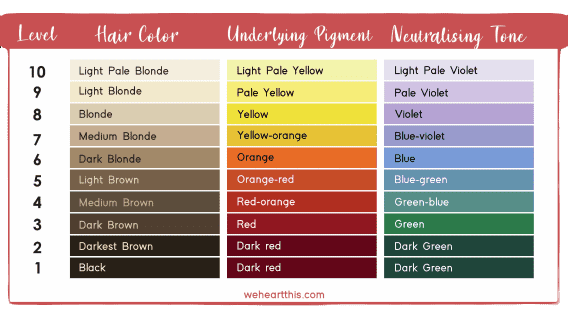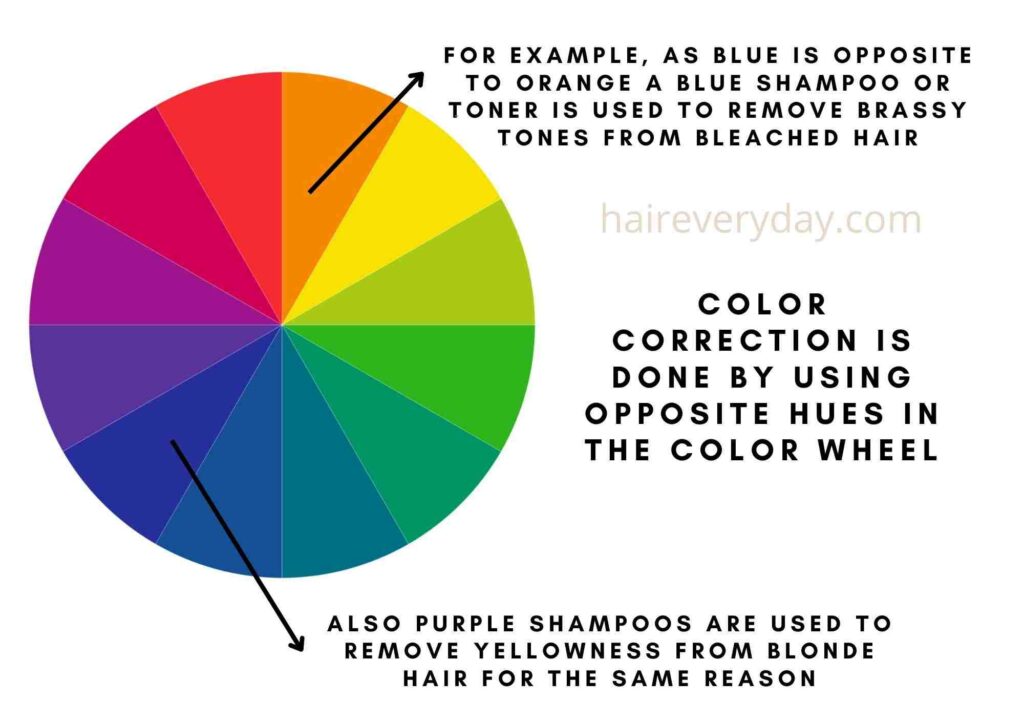Understanding The Hair Color Wheel
Table Of Content

This approach requires a blend of hair chemistry knowledge, precise product selection, and an ongoing commitment to learning and adapting to new trends in hair color correction. Understanding these aspects will empower you to achieve your desired hair color while maintaining hair health. The color wheel is your guide to understanding how different hues interact, helping you to predict the outcome of your color choices.
Watch This Video to See Dark Hair Bleached Correctly and Toned to Pearl Blonde All the Way from Dark Brown
This is because the underlying pigment in these shades of brown is red. That’s because red is opposite to green in the hair color chart, so they’ll neutralize each other and turn into ash or brown. Use a demi-permanent dye, which is gentler on porous hair, to avoid blotchy results. Remember, don’t rush the fill process; take your time to achieve a lasting, vibrant color. Avoid skipping the addition of warm tones to your formula, even if you desire a cool or ash finish, as these are necessary for a balanced end result. When you’re ready to mix hair colors, it’s crucial to understand the chemistry behind the process to achieve the perfect custom shade.
Picking the right toner
These products contain special pigments that will help to neutralize any unwanted brassy/orange tones in your hair without having to change the actual color. Good colorists will look at things like your skin tones, your hair condition, your natural coloring, hair porosity and pigment to determine the right colors for you. Secondary colors are created from a combination of two primary hues. For example, red plus yellow yields orange; blue plus yellow yields green; red plus blue yields purple.
Yellow
Talking about a hair color chart, we cannot forget blonde – the most sought-after dyed hair color. Nobody can resist the charm and radiance that comes with blonde hair color. Looking at a blonde hair color chart, you will see light blonde and white blonde.
Not only does it pull up every shade available; it also allows you to see what each color would look like in different lighting, creating a realistic hair simulation. Teamed with expert knowledge of the Lightening Curve and the Color Circle, it unlocks a new way to identify the most beautiful color blends. Colorists look at the processes your hair has already been through.
For example, red and yellow give us orange, yellow and blue create green, and blue and red result in purple. Utilizing the hair color wheel, you can select the appropriate complementary colors to cancel out undesired hues, ensuring a more desirable outcome. For those with natural hair, remember that your inherent color can affect how the new shade appears, potentially altering the intended result. If your hair is processed, especially if it’s blonde, toning may be necessary to neutralize unwanted yellow or orange tones, ensuring a clean canvas for the new color.
Fashionable Ways to Wear Blue Hair
If your skin looks like it contains both blue and green, then you probably a neutral skin tone. Mind that we speak about the levels of color (depth/lightness), not hair color itself! If the colors distract you from determining your hair level, take a photo of your hair and convert it to black and white image. This simple hack will let you know how dark or light your current hair color is. Learn how to use the hair color wheel to find out which shades and hues will work for you. Before you dye or tone your hair, try to study the color wheel and color theory.

In fact, you can use this tool or the color theory we’ve explained above for you to get the best out of your DIY hair dye. The first thing to note about complementary colors is that when you put them next to each other, they pop. That’s because a pair of complementary colors is made up of one cool tone and one warm tone, creating contrast. It shows what happens when you combine certain colors or when you remove a hue from a color, based on the color wheel. When considering the use of a Volume 10 developer, you’re choosing the gentlest form of developer strength available. It’s ideal when your goal is to deposit color without significant lifting of your natural hair shade.

Also, it’s important to know that dark brown hair can also have warm undertones. However, it’s important to note that these undertones may not always be visible to the naked eye. They usually become more apparent under certain lighting conditions or when the hair is lifted to a lighter color. With neutral undertones, well, you’re in luck because any shade can complement your skin tone.
The figure before the stroke denotes the depth (how light or dark the hair is), and the figure after indicates what colour you’ll see. When you get your hair coloured, you might hear your colourist reeling off all manner of random numbers. The Lightening Curve, seen below, is essentially a diagram that helps colorists determine the correct shade for their client’s hair. If you’re nervous about getting your tresses colored for the first time, you might find comfort in the fact that color theory is never wrong. The color wheel can sometimes cause a lot of head-shaking and confusion among hair dye virgins and even cosmetology newbies. Yellow is counteracted by purple, orange is neutralized by blue, and red is zapped away by green.
When you’re aiming for that perfect hair color, understanding complementary colors on the hair color wheel is crucial. These are the hues directly opposite each other, and they’ve the power to neutralize unwanted tones in your hair, leading to more balanced and appealing results. The position of colors on the hair color wheel indicates the tone.
Best Hair Colors for Brown Eyes - Southern Living
Best Hair Colors for Brown Eyes.
Posted: Fri, 02 Mar 2018 08:00:00 GMT [source]
With various shades ranging from dark to light, they can suit almost all skin tones. To rid your hair of unwanted yellow tones, use a purple shampoo and conditioner. Like we mentioned, purple is located directly across from yellow on the hair color wheel, making it the perfect shade to neutralize yellow aka brass. Colors that cancel each other out for hair are known as complementary colors. Examples include red and green, blue and orange, and purple and yellow. Pairing these colors can help neutralize unwanted tones in the hair.
Understanding these relationships is essential for achieving desired hair colors and correcting color mishaps. In another scenario, let’s imagine you’re a brunette who tried to go lighter, but your hair turned out with unwanted reddish or orange tones. Blue is the complementary color to orange on the hair color wheel. Therefore, you’d use a blue-toned shampoo or a toner to neutralize the orange and bring your hair to a more neutral brown. Let’s say you wanted to go blonde, but your hair turned out too yellow or brassy. On the hair color wheel, violet is the complementary color to yellow.
In this case, a violet-toned hair product like a purple shampoo or conditioner would be used to neutralize the yellow tones, bringing your hair to a more natural, cooler blonde. You can neutralize certain tones by going across the color wheel to see what counteracts that color. Analyzing your strands based on the color wheel and finding the right shades of toner will help you balance out those brassy colors and help you achieve the hair color of your dreams. To master the art of color neutralization, you’ll need to understand how to apply color theory to hair undertones.

Comments
Post a Comment